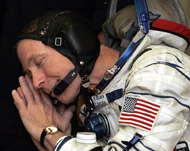Russian shuttle docks at space station
A Russian Soyuz TMA-7 spacecraft has docked flawlessly and ahead of schedule at the International Space Station, delivering US millionaire scientist Gregory Olsen and a new two-man crew.

Since the 2003 Columbia disaster grounded the US shuttle fleet, the United States has depended on Russian Soyuz and Progress craft to ferry its astronauts and supplies to the orbiting space station.
Discovery visited the station in July, but problems with the foam insulation on its external fuel tank cast doubts on when the shuttle would fly again.
Applause erupted from members of Olsen’s family, and US and Russian space officials gathered at Russian Mission Control in Korolyov outside Moscow when the docking was announced approximately 5 minutes before the 9.32am (0532 GMT) target.
It was conducted through automatic systems.
Olsen’s 31-year-old daughter, Krista Dibsie, asked by reporters how her father felt, said: “He’s never felt better. He actually talked to the doctor and said he felt excellent.
“I can’t wait to see him back on Earth,” she said, as her 4-year-old son, Justin, sat on her lap while holding his crayon drawings of rockets.
Payment
Later on Monday morning, the final air locks were to be opened and the Soyuz capsule passengers would meet Russian Sergei Krikalev and American John Phillips, who have inhabited the orbiting station for six months.
 |
|
Gregory Olsen prefers the term |
Astronaut William McArthur and cosmonaut Valery Tokarev are to man the station for the next six-month stint, while Olsen is to return to Earth on 11 October with the current crew on a Russian spacecraft.
On the eve of the Soyuz blast-off from the Baikonur Cosmodrome in Kazakhstan, Russian space officials warned that they could not guarantee McArthur’s return next spring unless Nasa paid for the flight.
But a US law passed in 2000 penalises countries that sell unconventional weapons and missile technology to Iran – and Russia is helping Iran build an $800 million atomic power plant, despite concerns Tehran will build nuclear weapons.
The US Senate has agreed to amend the measure and lift a ban on Nasa purchases of Soyuz seats until 2012. The House has yet to act on it.
Space tourism
Nasa’s international space station programme manager, William Gersteinmaier, said on Monday that McArthur would get home one way or another.
“We have a way home for him either on the shuttle or on the Soyuz,” he told reporters at Russian Mission Control, but would not say whether the astronaut would be able to return to Earth on schedule in April.
Anatoly Perminov, chief of the Russian space agency, said the European Space Agency could send up a ship to the station as early as the end of 2006.
The cash-strapped Russian space agency has turned to space tourism to generate money. Olsen is the third non-astronaut to visit the orbiting station, reportedly paying about $20 million.
The first two space tourists were California businessman Dennis Tito, and South African Mark Shuttleworth a year later.
Olsen has said he preferred the term “space flight participant” to “space tourist”.